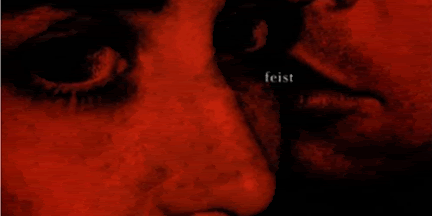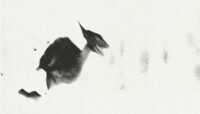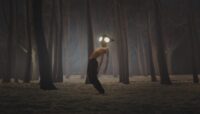
“One Evening”
from the album Let It Die
2005
[iTunes]
There are people who talk about blurring boundaries, those who work diligently to cultivate a curious palette, and then there are the artists for whom fusion is so organic it’s as if categories had never existed at all.
Leslie Feist is one of the naturals. Her new album, Let It Die, is an enchanted garden of songs that seems to have sprung, without calculation, from a bed of jazz, disco, gospel, vaudeville, trip-hop, torch singing, and classic pop. It’s old-time and contemporary, whimsical and minimalist, and as clear and shimmering as water.
 Feist |
The album, recorded in Feist’s adopted home of Paris with producer Chilly Gonzales, was released in Europe last year and in the United States this spring on the Interscope imprint Cherry Tree. It includes half a dozen originals and nearly as many cover songs: among them a crackling rethinking of the Bee Gees’ “Inside and Out,” an ambient take on the traditional “When I Was a Young Girl” cobbled of handclaps, distorted guitar, and twinkling keyboards, and a Technicolor rendering of Ron Sexmith’s “Secret Heart.”
“Willie Nelson is country, but is he really?” muses Feist. “He’s a great jazz guitarist and writes better folk songs than anyone. Is Nina Simone jazz or roots or blues? I’ve never been good at differentiating. It’s music that occupies a space in my mind and my heart.”
Feist’s resume is eclectic. She found her voice — a frank, dusky instrument — in church choirs in her native Calgary, and discovered her wild side with the Canadian punk band (not the British rockers) Placebo. At 19, after losing her voice on a grueling cross-Canadian tour, Feist moved to Toronto and picked up guitar. She toured as guitarist with indie-rockers By Divine Right and then hit the road with her roommate-turned-electroclash vixen Peaches, with whom she rapped in Spanish wearing aerobics outfits and holding a sock puppet.
“It was a great couple of years,” says Feist, who goes by her last name. “I was making my four-track demos and she was learning to make beats on the groovebox, and we’d meet in the kitchen and make pasta. She made her Teaches of Peaches record in the bedroom of the house where everyone hung out, this rotating cast of characters. We went from the living room to the stage.”
The musical collective Broken Social Scene, of which Feist is a member, grew out of those freeform nights, as did her collaboration with Gonzales. In 2003 Feist was touring Europe with Gonzales, who now lives in Berlin, when French producer Renaud Letang offered the pair the use of his studio. Their goal was modest: rerecord the songs from Feist’s five-year-old homemade tapes. It didn’t occur to either of them that the songs would be heard by anyone other than themselves.
“It felt very small and precious,” says Feist. “There was no label, there was no money changing hands. We were just seeing what we could do. It was one of those few selfish acts that doesn’t hurt anybody.”
Perhaps because Feist and Gonzales — whose low-lit, storybook arrangements make Let It Die glow — went into the studio with neither big plans nor great expectations, the songs feel less composed than discovered. That’s not to say the songwriting isn’t fully realized, but rather that the music sparkles with the sort of creative synergy that flourishes in the absence of pressure.
“We didn’t have a modus operandi, except that the common thread in all my recordings was simplicity,” says Feist. “I always sold myself short thinking it was because I didn’t have the ability to do anything complicated, but I’ve realized it’s my aesthetic: restraint, space between the notes, and conveying a mood with as little as possible. We recorded a lot, and then ran a rake through every track and took out whatever wasn’t necessary.”
Letang is a major producer in the European recording industry, and it wasn’t long before word got out about the young Canadian making visits to his Paris studio. Feist signed first with Polydor UK, which released Let It Die in 2004, and then with Cherry Tree for distribution in North America. She’s recently collaborated with Norwegian duo Kings of Convenience and British chanteuse Jane Birkin.
At last month’s Juno Awards, the Canadian equivalent of the Grammys, Feist took home two honors: for Alternative Album of the Year and Best New Artist. It was something of an eye-opener for an artist who until recently was comfortably underground.
”The Junos were never on my radar screen, and I never thought I was on theirs,” says Feist. ”I was on a sediment layer a few feet down. Suddenly I’m on the mainstage at the folk festivals. To win these is to readjust my perception of my layer of sediment.”~ Joan Anderman, Boston Globe


